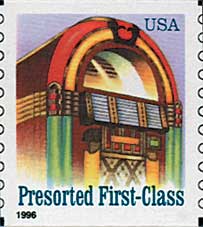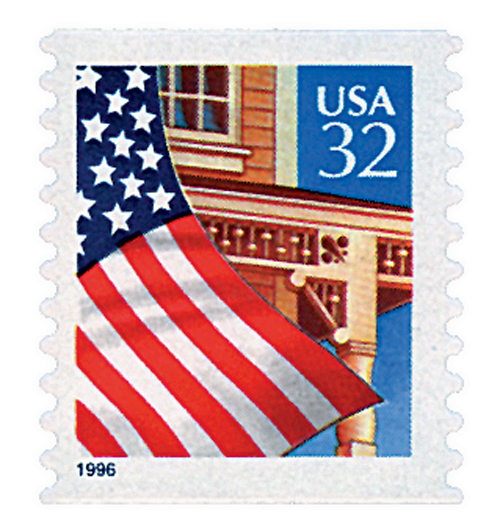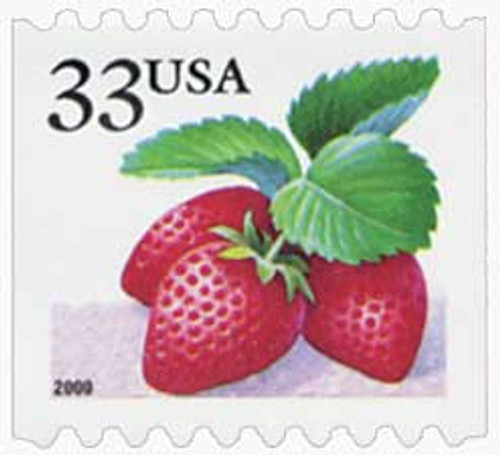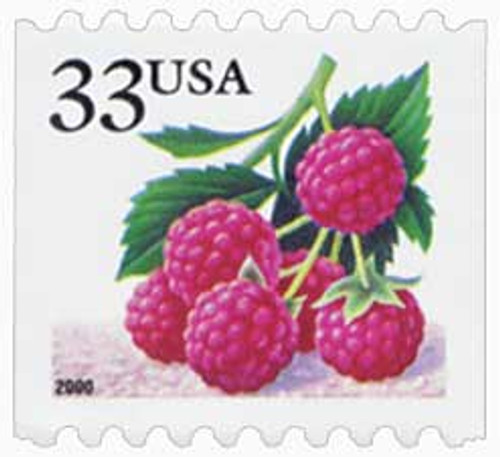
# 3404-07 - 2000 33c Fruit Berries
U.S. #3404-07
33¢ Fruit Berries
Coil Stamps
City: Buffalo, NY
Printed by: Guildford Gravure
Printing Method: Photogravure
Perforations: Serpentine die cut 8.5 horizontally
Color: Multicolored
Experimental Linerless Coil Stamps

On March 14, 1997, the USPS issued two linerless coil stamps on a small scale to test the potentially money-saving format.
Throughout the 1990s, self-adhesive stamps grew in popularity for their convenience. So the USPS began looking for ways to produce the stamps more efficiently.

Up until 1997, self-adhesive stamps were produced with a backing paper – a glossy paper the stamps could adhere to, but also be easily removed from. In an effort to cut costs and be more environmentally friendly, the USPS decided to experiment with linerless self-adhesive coils. In order to do this, the stamps would have to receive a special silicone coating to keep them from sticking to each other.
The process to produce these stamps would turn out to be quite complex. For example, the 32¢ Flag over Porch stamps were being printed by Stamp Venturers in Richmond, Virginia. They were shipped to 3M Corporation in St. Paul, Minnesota. There, they were coated with adhesive on the back and silicone on the front. The stamps were then shipped back to Stamp Venturers, cut down into 100-stamp coils, and packaged similarly to tape dispensers.
U.S. #3404-07
33¢ Fruit Berries
Coil Stamps
City: Buffalo, NY
Printed by: Guildford Gravure
Printing Method: Photogravure
Perforations: Serpentine die cut 8.5 horizontally
Color: Multicolored
Experimental Linerless Coil Stamps

On March 14, 1997, the USPS issued two linerless coil stamps on a small scale to test the potentially money-saving format.
Throughout the 1990s, self-adhesive stamps grew in popularity for their convenience. So the USPS began looking for ways to produce the stamps more efficiently.

Up until 1997, self-adhesive stamps were produced with a backing paper – a glossy paper the stamps could adhere to, but also be easily removed from. In an effort to cut costs and be more environmentally friendly, the USPS decided to experiment with linerless self-adhesive coils. In order to do this, the stamps would have to receive a special silicone coating to keep them from sticking to each other.
The process to produce these stamps would turn out to be quite complex. For example, the 32¢ Flag over Porch stamps were being printed by Stamp Venturers in Richmond, Virginia. They were shipped to 3M Corporation in St. Paul, Minnesota. There, they were coated with adhesive on the back and silicone on the front. The stamps were then shipped back to Stamp Venturers, cut down into 100-stamp coils, and packaged similarly to tape dispensers.













